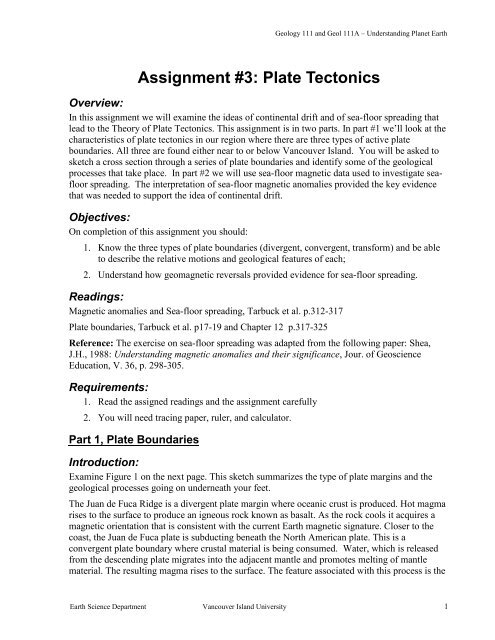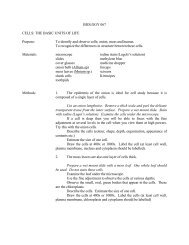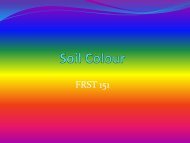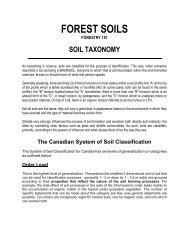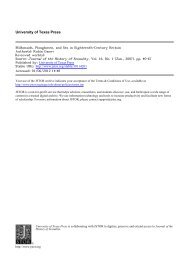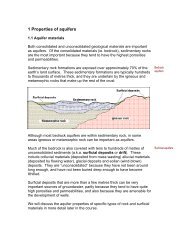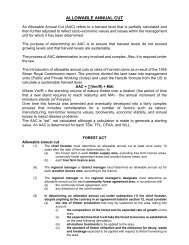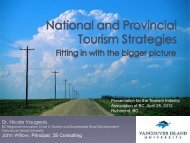Assignment #3: Plate Tectonics - web.mala.bc.ca - Vancouver Island ...
Assignment #3: Plate Tectonics - web.mala.bc.ca - Vancouver Island ...
Assignment #3: Plate Tectonics - web.mala.bc.ca - Vancouver Island ...
Create successful ePaper yourself
Turn your PDF publications into a flip-book with our unique Google optimized e-Paper software.
Geology 111 and Geol 111A – Understanding Planet Earth<br />
<strong>Assignment</strong> <strong>#3</strong>: <strong>Plate</strong> <strong>Tectonics</strong><br />
Overview:<br />
In this assignment we will examine the ideas of continental drift and of sea-floor spreading that<br />
lead to the Theory of <strong>Plate</strong> <strong>Tectonics</strong>. This assignment is in two parts. In part #1 we’ll look at the<br />
characteristics of plate tectonics in our region where there are three types of active plate<br />
boundaries. All three are found either near to or below <strong>Vancouver</strong> <strong>Island</strong>. You will be asked to<br />
sketch a cross section through a series of plate boundaries and identify some of the geologi<strong>ca</strong>l<br />
processes that take place. In part #2 we will use sea-floor magnetic data used to investigate seafloor<br />
spreading. The interpretation of sea-floor magnetic anomalies provided the key evidence<br />
that was needed to support the idea of continental drift.<br />
Objectives:<br />
On completion of this assignment you should:<br />
1. Know the three types of plate boundaries (divergent, convergent, transform) and be able<br />
to describe the relative motions and geologi<strong>ca</strong>l features of each;<br />
2. Understand how geomagnetic reversals provided evidence for sea-floor spreading.<br />
Readings:<br />
Magnetic anomalies and Sea-floor spreading, Tarbuck et al. p.312-317<br />
<strong>Plate</strong> boundaries, Tarbuck et al. p17-19 and Chapter 12 p.317-325<br />
Reference: The exercise on sea-floor spreading was adapted from the following paper: Shea,<br />
J.H., 1988: Understanding magnetic anomalies and their signifi<strong>ca</strong>nce, Jour. of Geoscience<br />
Edu<strong>ca</strong>tion, V. 36, p. 298-305.<br />
Requirements:<br />
1. Read the assigned readings and the assignment <strong>ca</strong>refully<br />
2. You will need tracing paper, ruler, and <strong>ca</strong>lculator.<br />
Part 1, <strong>Plate</strong> Boundaries<br />
Introduction:<br />
Examine Figure 1 on the next page. This sketch summarizes the type of plate margins and the<br />
geologi<strong>ca</strong>l processes going on underneath your feet.<br />
The Juan de Fu<strong>ca</strong> Ridge is a divergent plate margin where oceanic crust is produced. Hot magma<br />
rises to the surface to produce an igneous rock known as basalt. As the rock cools it acquires a<br />
magnetic orientation that is consistent with the current Earth magnetic signature. Closer to the<br />
coast, the Juan de Fu<strong>ca</strong> plate is subducting beneath the North Ameri<strong>ca</strong>n plate. This is a<br />
convergent plate boundary where crustal material is being consumed. Water, which is released<br />
from the descending plate migrates into the adjacent mantle and promotes melting of mantle<br />
material. The resulting magma rises to the surface. The feature associated with this process is the<br />
Earth Science Department <strong>Vancouver</strong> <strong>Island</strong> University 1
Geology 111 and Geol 111A – Understanding Planet Earth<br />
linear chains of vol<strong>ca</strong>noes <strong>ca</strong>lled the Cas<strong>ca</strong>dia vol<strong>ca</strong>nic belt. This belt stretches from Mendicino,<br />
California to Bella Coola, BC, and includes vol<strong>ca</strong>noes such as Mt. Shasta, Mt. St. Helens, Mt.<br />
Rainier, Mt. Baker and Mt. Garibaldi. South of Mendicino and north of Bella Coola the oceanic<br />
crust of the Pacific plate is not subducting, instead it is moving laterally relative to the North<br />
Ameri<strong>ca</strong>n plate along the San Andreas and Queen Charlotte transform faults respecitively.<br />
Transform<br />
Fault<br />
Mid<br />
Ocean<br />
Ridge:<br />
Juan de<br />
Fu<strong>ca</strong><br />
Ridge<br />
Transform<br />
Fault<br />
A<br />
Triple<br />
Junction<br />
● Nanaimo<br />
Figure 1. Showing lo<strong>ca</strong>l plate boundaries and their relative motions from Geologi<strong>ca</strong>l Survey of Canada<br />
Pacific Geoscience Centre, 1999. Earthquakes and <strong>Plate</strong> <strong>Tectonics</strong> in Western Canada.<br />
See < http://earthquakes<strong>ca</strong>nada.nr<strong>ca</strong>n.gc.<strong>ca</strong>/index-eng.php > for more information.<br />
Earth Science Department <strong>Vancouver</strong> <strong>Island</strong> University 2<br />
A′<br />
Subduction<br />
Zone
<strong>Assignment</strong> 3: Part 1<br />
Geology 111 and Geol 111A – Understanding Planet Earth<br />
Name: ________________________<br />
GEOL/Section: _______________________<br />
Procedure:<br />
Figure 1 shows a plan view of the geologi<strong>ca</strong>l processes occurring beneath <strong>Vancouver</strong> <strong>Island</strong>.<br />
Your assignment is to sketch and label a cross section of the plates and illustrate how they are<br />
moving relative to each other. (A cross-section is a view as if slicing through the earth). The<br />
lo<strong>ca</strong>tion of the section you are asked to sketch is marked by the line A-A' on Figure 1. Draw the<br />
cross-section as viewing to the north.<br />
The figures in Tarbuck et al. should help you to visualize what is occurring at plate tectonic<br />
boundaries. There also is a poster on the wall in the lab (Geos<strong>ca</strong>pe Nanaimo) that also shows a<br />
cut away view of the area of your assignment.<br />
Start by drawing a line that depicts the approximate changes in elevation earth’s surface going<br />
from the deep ocean floor at A to the Coast Mountains at A’. Then draw the lo<strong>ca</strong>tion of the<br />
tectonic plates below, with particular attention on the subduction zone and mid-ocean ridge.<br />
Make sure you show the relative motions of the plates, the lo<strong>ca</strong>tions of any vol<strong>ca</strong>nic activity, the<br />
source of magma, and indi<strong>ca</strong>te where you think earthquakes might occur.<br />
A A’<br />
Earth Science Department <strong>Vancouver</strong> <strong>Island</strong> University 3
Part 2, Sea-floor Spreading:<br />
Introduction:<br />
Geology 111 and Geol 111A – Understanding Planet Earth<br />
Understanding the patterns of sea-floor magnetism:<br />
A magnetometer is an instrument that is used to measure very small spatial variations in the<br />
intensity of the earth’s magnetic field. Magnetometers <strong>ca</strong>n be moved around on land (usually by a<br />
person on foot), in the air (towed beneath an aircraft) or at sea (towed behind a ship). Studies of<br />
magnetic variations are useful in geologi<strong>ca</strong>l mapping and exploration for minerals be<strong>ca</strong>use they<br />
provide general information about variations in rock types (e.g. granite versus basalt), and about<br />
the presence of rocks that have signifi<strong>ca</strong>ntly more magnetic minerals than other rocks (e.g. iron<br />
ores with magnetite).<br />
During WWII, naval ships accompanying supply convoys crossing the Atlantic Ocean towed<br />
sensitive magnetometers behind. These magnetometers were looking for submarines (a large<br />
metal body <strong>ca</strong>pable of deflecting the Earth’s magnetic field lo<strong>ca</strong>lly). The operators of the<br />
magnetometers found strange patterns of magnetic field reversals as they traversed the Atlantic.<br />
In the mid-1950s the U.S. Office of Naval Research undertook a systematic oceanographic<br />
survey of an area off the west coast. After much persuasion, they agreed to a request from the<br />
Scripps Institute of Oceanography to tow a magnetometer behind the ship. The results of this<br />
survey, which, for the first time, included many precisely lo<strong>ca</strong>ted parallel survey lines, are shown<br />
on Figure 2 below - a confusing, but systematic pattern of contrasting strips of positive<br />
magnetism (black areas) and negative magnetism (white areas).<br />
In the following years similar surveys were done in other areas - with similar results. However,<br />
the origin of the patterns remained a mystery until 1963 when a solution was proposed by a<br />
Cambridge graduate student (Fred Vine) and his thesis advisor (Drummond Matthews), and<br />
(independently) by a Geologi<strong>ca</strong>l Survey of Canada Geologist (Lawrence Morely).<br />
Vine, Matthews and Morely (VMM) suggested that the patterns could be related to the creation<br />
of new oceanic crust at a spreading centre, and to the periodic reversals of the earth's magnetic<br />
field. The idea is that as new basaltic crust is created its minerals (particularly magnetite) become<br />
magnetized in alignment with the existing magnetic field of the earth. Rock formed during a<br />
period of normal magnetism will give a positive magnetic anomaly be<strong>ca</strong>use the rock has the same<br />
polarity as the earth’s existing magnetic field, while rock formed during a period of reverse<br />
magnetism will give a negative magnetic anomaly. The stripes on the ocean floor, it was<br />
suggested, represent different ages of oceanic basaltic rock, which have been pushed away to<br />
either side of a spreading centre and replaced by younger basaltic rock.<br />
To begin with the VMM hypothesis was largely ignored, firstly be<strong>ca</strong>use in the early 1960's the<br />
idea of sea-floor spreading itself was not well accepted, secondly be<strong>ca</strong>use the chronology of<br />
magnetic-field reversals was not well known, and thirdly be<strong>ca</strong>use there was not enough sea-floor<br />
magnetic data to test the idea. Much more data be<strong>ca</strong>me available within a few years, and once<br />
others had a chance to verify the phenomenon for them selves the hypothesis be<strong>ca</strong>me widely<br />
accepted, and in fact played a crucial role in the general acceptance of continental drift and plate<br />
tectonics a few years later.<br />
Earth Science Department <strong>Vancouver</strong> <strong>Island</strong> University 4
Geology 111 and Geol 111A – Understanding Planet Earth<br />
Figure 2 Systematic patterns of magnetic anomalies of the west coast of North Ameri<strong>ca</strong> from Marshak, S.<br />
2001: Earth, Portrait of a Planet.<br />
Figure 3 Lo<strong>ca</strong>tion of the Pacific Antarctic Ridge and profiles at 51.6S & 47.7S<br />
Earth Science Department <strong>Vancouver</strong> <strong>Island</strong> University 5
Geology 111 and Geol 111A – Understanding Planet Earth<br />
A confirmation of the Vine-Matthews-Morley hypothesis was made in 1966, when W. Pitman<br />
analyzed several profiles of sea-floor magnetization across the Pacific-Antarctic Ridge (Figure<br />
3), and found that one of the profiles, the Eltanin-19 profile, Figure 4, showed remarkable<br />
symmetry, exactly as implied by the hypothesis.<br />
In this exercise you will make a number of predictions based on the VMM hypothesis, and then<br />
use some magnetic data to test them. Some useful predictions are as follows (although you might<br />
be able to think of others):<br />
since the spreading at a ridge is symmetri<strong>ca</strong>l on either side of the ridge axis, the pattern of<br />
positive and negative magnetism should also be symmetri<strong>ca</strong>l,<br />
magnetic profiles at various points along a ridge, and at different ridges around the world,<br />
should be generally comparable,<br />
the positive and negative magnetic features should correlate with the known chronology<br />
of magnetic-field reversals, and<br />
the corresponding rates of spreading (as determined from the magnetic chronology)<br />
should be consistent with typi<strong>ca</strong>l oceanic-ridge spreading rates (i.e. a few cm/year)<br />
Figure 4 Sea-floor magnetic anomalies from the Eltanin-19 traverse.<br />
Earth Science Department <strong>Vancouver</strong> <strong>Island</strong> University 6
Geology 111 and Geol 111A – Understanding Planet Earth<br />
<strong>Assignment</strong> 3: Part 2 Name: ______________________________<br />
GEOL/Section: ______________________<br />
1) Symmetry across the ridge<br />
Profiles of the magnetic patterns on the east and west sides of the Pacific-Antarctic ridge at 51.6º<br />
S are shown on Figure 5. Compare the profiles - peak for peak and valley for valley. A good<br />
way to do this is to trace the profile onto a separate sheet of paper and place it upside-down on<br />
the other profile (axis to axis), and then hold the sheets up to the light. It is best to choose the<br />
51.6 East profile to trace.<br />
Figure 5. Magnetic profile at 51.6S on the west and east sides of the Pacific-Antarctic Ridge.<br />
Earth Science Department <strong>Vancouver</strong> <strong>Island</strong> University 7
Geology 111 and Geol 111A – Understanding Planet Earth<br />
Compare the profile you traced to the profile from the other side. (Note: make sure you hand in<br />
your traced profile)<br />
Q1. Do you think that the patterns are generally similar on opposite sides of the ridge, that is, do<br />
they show a reasonable degree of biaxial symmetry? What might this biaxial symmetry mean?<br />
2) Correlation along the ridge<br />
A magnetic profile is available for the same ridge at 47.7º S (approx. 450 km north of the other<br />
profile) and is shown on Figure 6 (east side only). A first glance this looks somewhat similar to<br />
that of the east side profile at 51.6 S in Figure 5. However, in order to compare these profiles<br />
more <strong>ca</strong>refully, use the six well-defined positive peaks (normal polarity) that are identified and<br />
labelled as: a, b, c, d, e & f on the 47.7º S profile (Figure 6), and identify the matching positive<br />
peaks on the 51.6S (east side) profile in Figure 5.<br />
For each of these peaks measure the distance in kilometres from the ridge axis (at 0) to the centre<br />
of the peak using the s<strong>ca</strong>le given, and record the information in Columns 1 & 2 of Table 1. Then<br />
<strong>ca</strong>lculate the ratio of the 47.7S profile distance to the 51.6S profile distance, and write that in<br />
Column 3.<br />
Figure 6 Magnetic profile at 47.7 S (east side) of the Pacific-Antarctic ridge.<br />
Earth Science Department <strong>Vancouver</strong> <strong>Island</strong> University 8
Geology 111 and Geol 111A – Understanding Planet Earth<br />
Q2: What does the ratio information tell you about the probable rates of spreading at these two<br />
points on the ridge?<br />
Peak<br />
a<br />
b<br />
c<br />
d<br />
e<br />
f<br />
Column 1 Column 2 Column 3 Column 4 Column 5 Column 6 Column 7 Column 8<br />
Distance<br />
to peak<br />
on east<br />
side 51.6º<br />
S (km)<br />
Distance<br />
to peak<br />
on east<br />
side 47.7º<br />
S (km)<br />
Distance<br />
Ratio<br />
Dist@<br />
47.7S to<br />
dist@<br />
51.6S<br />
Date of<br />
magnetic<br />
event<br />
(Million<br />
years, Ma)<br />
Spreading<br />
rate<br />
(km/Ma) on<br />
east side<br />
51.6º S<br />
Spreading<br />
rate (km/Ma)<br />
on east side<br />
47.7º S<br />
Average Spreading Rates – cm/year<br />
Spreading<br />
rate<br />
(cm/year)<br />
on east side<br />
51.6º S<br />
Table 1- Analysis of Data from east side of the Pacific Antarctic Ridge at Profiles 51.6S and 47.7S<br />
Spreading<br />
rate<br />
(cm/year)<br />
on east side<br />
47.7º S<br />
3) Correlation with the magnetic time-s<strong>ca</strong>le<br />
The magnetic reversal time s<strong>ca</strong>le for the past 4.5 Ma is primarily derived from <strong>ca</strong>reful work<br />
<strong>ca</strong>rried out on rocks of the continental crust, and is shown on Figure 7. Try to correlate some of<br />
the peaks that you selected on Figures 5 or 6 with the various events described on this time s<strong>ca</strong>le,<br />
and record the approximate dates of these events in Column 4 of the table above.<br />
This is a difficult part of the assignment as it requires some level of ‘subjectivity’. Try and match<br />
the widths of the peaks (which are in the normal magnetic fields) in one of the profiles (Figures 5<br />
or 6) with the widths of the normal magnetic periods (black) found in Figure 7. Choose the<br />
midpoint of the period of normal magnetism, which should correlate with the tip of the peak.<br />
Earth Science Department <strong>Vancouver</strong> <strong>Island</strong> University 9
Geology 111 and Geol 111A – Understanding Planet Earth<br />
Figure 7 Magnetic reversal events versus geologi<strong>ca</strong>l time, based on vol<strong>ca</strong>nic rocks on continental crust<br />
Q3: From your matching exercise how well do the peaks of the magnetic profiles from the<br />
Pacific-Antarctic ridge correlate with the chronology of magnetic field reversals found on<br />
continental crust? What does this tell you?<br />
4) Spreading Rate Calculations<br />
Now that you have an estimate of distance (km) and time (Ma) it is possible to determine the<br />
speed of ocean plate growth or more correctly the ‘spreading rate’ of oceanic crust. For each peak<br />
and each profile do this by dividing the distances (km) by the date of the magnetic event (Ma)<br />
and fill in Columns 5 and 6.<br />
However, we typi<strong>ca</strong>lly think of plate movement in terms of cm/year which is easier to visualize<br />
rather than km/years. In order to do this you will have to convert you results in Columns 5 and 6<br />
from km/Ma to cm/year. Once you have figured out how to do this fill in Columns 7 and 8.<br />
In order to get an average for the spreading rates at the two lo<strong>ca</strong>tions add the spreading rates and<br />
divide by the number of peaks or sample points. Report your final averages in the table.<br />
Q4 Are these reasonable rates for a spreading ridge? How do they compare to rates reported in<br />
your textbook? Do your findings satisfy Vine Matthews and Morely (VMM)’s hypothesis for<br />
sea-floor spreading? What does this evidence support in terms of the plate tectonic theory?<br />
Earth Science Department <strong>Vancouver</strong> <strong>Island</strong> University 10


